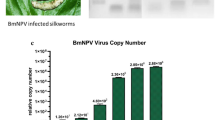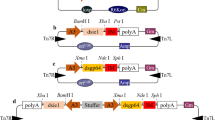Abstract
The Bombyx mori nucleopolyhedrovirus (BmNPV) is one of the most destructive diseases in silkworm, which has caused the main damage to sericulture industry. In this study, we developed a system of RNAi to prevent the BmNPV infection using the piggyBac transposon-derived targeting short hairpin RNA (shRNA) interference. The shRNAs targeting the genes of i.e.-1, lef-1, lef-2 and lef-3 of BmNPV were designed and used to inhibit the intracellular replication or multiplication of BmNPV in Bm cells. The highest activity was presented in the shRNA targeting the i.e.-1c of BmNPV, of which the inhibition rate reached 94.5 % in vitro. Further a stable Bm cell line of piggyBac transposon-derived targeting shRNA interference against BmNPV was established, which has a highly efficacious suppression on virus proliferation. These results indicated that the recombinant shRNA expression system was a useful tool for resistance to BmNPV in vitro. The approach by recombinant shRNAs opens a door of RNAi technology as a strategy that offering technically simpler, cheaper, and quicker gene knockdown for promising research and biotechnology application on silkworm lethal diseases.





Similar content being viewed by others
References
Rohrmann GF (1994) Nuclear polyhedrosis viruses. In: Webster RG, Granoff A (eds) Encyclopedia of virology. Academic Press, London, pp 130–136
Crook NE (1994) Granulosis viruses. In: Webster RG, Granoff A (eds) Encyclopedia of virology. Academic Press, London, pp 127–130
Maeda S, Majima K (1990) Molecular cloning and physical mapping of the genome of Bombyx mori nuclear polyhedrosis virus. J Gen Virol 71:1851–1855
Majima K, Kobara R, Maeda S (1993) Divergence and evolution of homologous regions of Bombyx mori nuclear polyhedrosis virus. J Virol 67:7513–7521
Kondo A, Maeda S (1991) Host range expansion by recombination of the baculoviruses Bombyx mori nuclear polyhedrosis virus and Autographa californica nuclear polyhedrosis virus. J Virol 65:3625–3632
Kanginakudru S, Royer C, Edupalli SV, Jalabert A, Mauchamp B, Chandrashekaraiah PSV, Chavancy G, Couble P, Nagaraju J (2007) Targeting ie-1 gene by RNAi induces baculoviral resistance in lepidopteran cell lines and in transgenic silkworms. Insect Mol Biol 16(5):635–644
Isobe R, Kojima K, Matsuyama T, Quan GX, Kanda T, Tamura T, Sahara K, Asano SI, Bando H (2004) Use of RNAi technology to confer enhanced resistance to BmNPV on transgenic silkworms. Arch Virol 149:1931–1940
Kool M, Voeten JTM, Goldbach RW, Vlak JM (1994) Functional mapping of regions of the Autographa californica nuclear polyhedrosis viral genome required for DNA replication. Virology 198(2):680–689
Lu A, Miller L (1995) The roles of eighteen baculovirus late expression factor genes in transcription and DNA replication. J Virol 69:975–982
Pathakamuri JA, Theilmann DA (2002) The acidic activation domain of the baculovirus trans activator IE1 contains a virus-specific domain essential for DNA replication. J Virol 76:5598–5604
Mikhailov VS, Rohrmann GF (2002) Baculovirus replication factor LEF-1 is a DNA primase. J Virol 76:2287–2297
Evans JT, Leisy DJ, Rohrmann GF (1997) Characterization of the interaction between the baculovirus replication factors LEF-1 and LEF-2. J Virol 71:3114–3119
Evans JT, Rosenblatt GS, Leisy DJ, Rohrmann GF (1999) Characterization of the interaction between the baculovirus ssDNA-binding protein (LEF-3) and putative helicase (P143). J Gen Virol 80:493–500
McDougal VV, Guarino LA (2000) The Autographa californica nuclear polyhedrosis virus p143 gene encodes a DNA helicase. J Virol 74:5273–5279
McDougal VV, Guarino LA (1999) Autographa californica nuclear polyhedrosis virus DNA polymerase: measurements of processivity and strand displacement. J Virol 73:4908–4918
Huh NE, Weaver RF (1990) Categorizing some early and late transcripts directed by the Autographa californica nuclear polyhedrosis virus. J Gen Virol 71:2195–2200
Huh NE, Weaver RF (1990) Identifying the RNA polymerases that synthesize specific transcripts of the Autographa californica nuclear polyhedrosis virus. J Gen Virol 71:195–201
Hoopes RRJ, Rohrmann GF (1991) In vitro transcription of baculovirus immediate early genes: accurate mRNA initiation by nuclear extracts from both insect and human cells. Proc Natl Acad Sci USA 88:4513–4517
Glocker B, Hoopes RRJ, Hodges L, Rohrmann GF (1993) In vitro transcription from baculovirus late gene promoters: accurate mRNA initiation by nuclear extracts prepared from infected Spodoptera frugiperda cells. J Virol 67:3771–3776
Guarino LA, Summers MD (1987) Nucleotide sequence and temporal expression of a baculovirus regulatory gene. J Virol 61:2091–2099
Guarino LA, Summers MD (1986) Functional mapping of a trans-activating gene required for expression of a baculovirus delayed-early gene. J Virol 57:563–571
Guarino LA, Summers MD (1986) Interspersed homologous DNA of Autographa californica nuclear polyhedrosis virus enhances delayed-early gene expression. J Virol 60:215–223
Nissen MS, Friesen PD (1989) Molecular analysis of the transcriptional regulatory region of an early baculovirus gene. J Virol 63:493–503
Carson DD, Summers MD, Guarino LA (1991) Molecular analysis of a baculovirus regulatory gene. Virology 182:279–286
Passarelli AL, Miller LK (1993) Three baculovirus genes involved in late mid very late gene expression: ie-1, ie-n, and lef-2. J Virol 67:2149–2158
Kovacs GR, Choi J, Guarino LA, Summers MD (1992) Functional dissection of the Autographa californica nuclear polyhedrosis virus immediate-early 1 transcriptional regulatory protein. J Virol 66:7429–7437
Kool M, Ahrens CH, Vlak JM, Rohrmann GF (1995) Replication of baculovirus DNA. J Gen Virol 76(9):2103–2118
Passarelli AL, Miller LK (1993) Identification and characterization of lef-1, a baculovirus gene involved in late and very late gene expression. J Virol 67:3481–3488
Carson DD, Guarino LA, Stjmmers MD (1988) Functional mapping of an AcNPV immediate early gene which augments expression of the IE-1 trans-activated 39 k gene. Virology 162:444–451
Dobos P, Cochran MA (1980) Protein synthesis in cells infected by Autographa californica nuclear polyhedrosis virus (AcNPV): the effect of cytosine arabinoside. Virology 103:446–464
Friesen PD, Miller LK (1986) The regulation of baculovirus gene expression. Curr Top Microbiol Immunol 131:31–49
Rice WC, Miller LK (1986) Baculovirus transcription in the presence of inhibitors and in nonpermissive Drosophila cells. Virus Res 6:155–172
Hang X, Dong W, Guarino LA (1995) The lef-3 gene of Autographa californica nuclear polyhedrosis virus encodes a single-stranded DNA-binding protein. J Virol 69:3924–3928
Riu L, Li H, Li WX, Ding SW (2004) RNA-based immunity in insects. In SGM Symposium 63: Microbe–vector Interactions in Vector-borne Diseases (Smith, G.L., Osbourn, A. And Gillespie, S.H., eds), pp. 63–74. Cambridge University Press
Subbaiah EV, Royer C, Kanginakudru S, Satyavathi VV, Babu AS, Sivaprasad V, Chavancy G, DaRocha M, Jalabert A, Mauchamp B, Basha I, Couble P, Nagaraju J (2013) Engineering silkworms for resistance to baculovirus through multigene RNA interference. Genetics 193:63–75
Jarvis DL, Weinkauf C, Guarino LA (1996) Immediate: early baculovirus vectors for foreign gene expression in transformed or infected insect cells. Protein Exp Purif 8:191–203
Jost S, Birgit KL, Heidrun K, Sandra S, Leona P, Jan M, Ralf K, Jens CB, Frieder S (2005) Single copy shRNA configuration for ubiquitous gene knockdown in mice. Nucl Acids Res 33(7):e67
Ohtsuka D, Nakatsukasa T, Fujita R, Asano SI, Sahara K, Bando H (2008) Use of Bombyx mori U6 promoter for inducing gene-silencing in silkworm Cells. J Insect Biotechnol Sericology 77:125–131
Livak KJ, Schmittgen TD (2001) Analysis of relative gene expression data using real-time quantitative PCR and the 2(-Delta Delta C(T)). Methods 25:402–408
Fire A, Xu S, Montgomery MK, Kostas SA, Driver SE, Mello CC (1998) Montgomery M.K. potent and specific genetic interference by double-stranded RNA in Caenorhabditis elegans. Nature 391:806–811
Hammond SM, Caudy AA, Hannon GJ (2001) Post transcriptional gene silencing by double-stranded RNA. Nat Rev Genet 2:1110–1119
Brummelkamp TR, Bernards R, Agami R (2002) A system for stable expression of short interfering RNAs in mammalian cells. Science 296:550–553
Elbashir SM, Harborth J, Lendeckel W, Yalcin A, Weber K, Tuschl T (2001) Duplexes of 21-nucleotide RNAs mediate RNA interference in cultured mammalian cells. Nature 411:494–498
Liu Y, Alan H, Alexander R, Charles ES (1998) Double-strand RNA-specific adenosine deaminase: nucleic acid binding properties. Methods 15:199–205
Xu Y, Zhu CG, Jin YF, Zhang YZ (2004) Inhibition of BmNPV replication in Bombyx mori cell by dsRNA triggered RNA interference. Chin Sci Bull 49(12):1261–1266
Acknowledgments
The work was supported by the National Basic Research Program of China under grand No. 2012CB114601 and the National Natural Science Foundation of China (No. NSFC:31372374/C1703), the Science and Technology Innovation Team of Zhejiang Province (No. 2010R50031) and Chinese Universities Scientific Fund.
Author information
Authors and Affiliations
Corresponding author
Rights and permissions
About this article
Cite this article
Zhou, F., Chen, Rt., Lu, Y. et al. piggyBac transposon-derived targeting shRNA interference against the Bombyx mori nucleopolyhedrovirus (BmNPV). Mol Biol Rep 41, 8247–8254 (2014). https://doi.org/10.1007/s11033-014-3726-0
Received:
Accepted:
Published:
Issue Date:
DOI: https://doi.org/10.1007/s11033-014-3726-0




